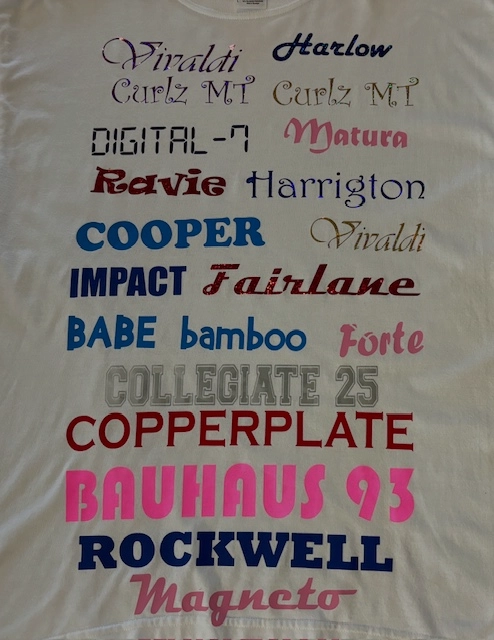The Art of Custom-made Needlework: Opening the Tricks to Creating One-of-a-kind and Memorable Designs
The keys to creating custom-made embroidery styles that mesmerize the eye and leave a long lasting impact lie in a fragile balance of strategy, creativity, and focus to information. As we delve right into the globe of custom needlework, we discover the nuanced interaction in between thread option, stitch complexity, and style personalization that elevates a simple garment to a job of art.
Selecting the Right Needlework Threads
When picking embroidery strings, what essential elements should you take into consideration to make certain the very best outcomes for your customized layouts? The selection of embroidery thread is important in determining the final end result of your embroidered style. One of the main factors to consider is the product of the string. Various materials such as cotton, polyester, rayon, and silk supply varying degrees of luster, longevity, and appearance. It is necessary to choose a string material that complements the material you are embroidering on and lines up with the preferred appearance of the style.
Moreover, the weight or thickness of the string plays a substantial function in the appearance of the needlework. Thicker strings can include measurement and structure to your design, while finer threads are excellent for detailed information and tiny message. Additionally, considering the shade fastness and washability of the thread is critical to make certain that your personalized styles preserve their high quality and vibrancy with time. By very carefully reviewing these factors and picking top notch strings that fulfill your particular demands, you can improve the aesthetic appeal and durability of your stitched productions.
Exploring Different Stitch Strategies
To look into the world of 'Exploring Different Stitch Techniques', one must grasp the ins and outs and nuances that each stitching technique gives the art of embroidery. Various stitch techniques not just add visual rate of interest yet also contribute to the general texture and measurement of the layout. One preferred stitch method is the satin stitch, which entails very closely stuffed parallel stitches to produce a smooth and shiny surface, suitable for completing shapes and creating strong outlines.
On the various other hand, the backstitch is a versatile strategy often used for describing and including fine details. It entails sewing backwards to produce a strong line of embroidery. Additionally, the French knot stitch includes a tactile aspect to styles, perfect for producing distinctive accents like blossom facilities or decorative touches.
Checking out various stitch techniques permits embroiderers to have fun with light, shadow, and depth within their layouts, raising the visual appeal and artistic high quality of their needlework tasks. By grasping numerous sewing methods, one can unlock limitless possibilities for producing unique and memorable custom embroidery pieces.
Incorporating Personalized Style Components
Having explored the ins and outs of different stitch techniques such as the satin stitch, backstitch, and French knot, the emphasis currently changes towards incorporating tailored style components in custom needlework jobs. Personalized style elements play a vital duty in making embroidery tasks genuinely unique and remarkable.
One more method to incorporate tailored design components is by including icons or motifs that hold unique meaning to the recipient or show their interests and personality. For example, including a favorite blossom, pet, or hobby-related icon can make the needlework design a lot more meaningful and individualized. In addition, selecting shades that reverberate with the recipient or align with the desired theme can better enhance the customization of the needlework job.
Mastering the Art of Shade Sychronisation

One secret facet of color control is understanding color concept. This consists of knowing just how different colors communicate with each other, the emotions they share, and how they can be integrated to develop visually enticing layouts. By applying color concept concepts, embroiderers can create unified shade palettes that improve the general appearance of the design.
Furthermore, focusing on comparison is crucial in color sychronisation. Making use of contrasting shades can help particular aspects of the layout pop, improve legibility, and produce an aesthetically vibrant embroidery piece. By understanding the art of shade coordination, embroiderers can raise their styles and develop remarkable pieces that resonate with clients and audiences alike.
Enhancing Appearance With Advanced Embroidery Stitches

Bullion knots, on the other hand, can be utilized to produce twisted, ropelike aspects that add an extravagant feel to the embroidery. Experimenting with these innovative needlework stitches permits you to press the limits of conventional embroidery and develop genuinely one-of-a-kind and aesthetically attractive men's tailored clothing textures in your layouts.
Verdict
In final thought, the art of custom embroidery involves a mix of selecting the right strings, checking out different stitch strategies, integrating individualized design components, grasping color control, and boosting appearance with sophisticated stitches. By understanding and applying these crucial elements, embroiderers can develop special and unforgettable styles that showcase their imagination and skill. Needlework enthusiasts can open the secrets to developing beautiful and custom pieces that stick out and leave a long lasting impact.